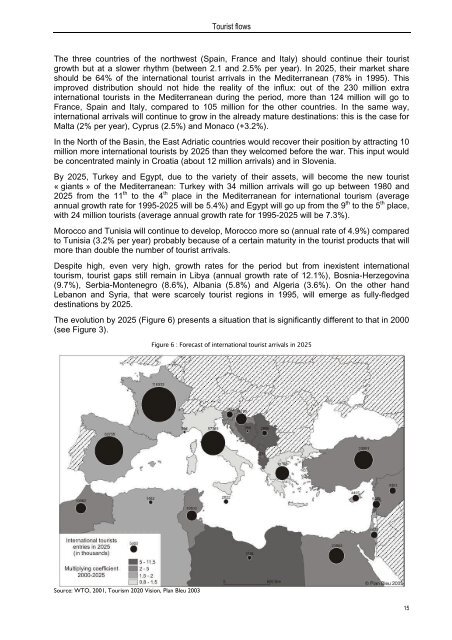dossier sur le tourisme et le développement durable
dossier sur le tourisme et le développement durable
dossier sur le tourisme et le développement durable
You also want an ePaper? Increase the reach of your titles
YUMPU automatically turns print PDFs into web optimized ePapers that Google loves.
Tourist flows<br />
The three countries of the northwest (Spain, France and Italy) should continue their tourist<br />
growth but at a slower rhythm (b<strong>et</strong>ween 2.1 and 2.5% per year). In 2025, their mark<strong>et</strong> share<br />
should be 64% of the international tourist arrivals in the Mediterranean (78% in 1995). This<br />
improved distribution should not hide the reality of the influx: out of the 230 million extra<br />
international tourists in the Mediterranean during the period, more than 124 million will go to<br />
France, Spain and Italy, compared to 105 million for the other countries. In the same way,<br />
international arrivals will continue to grow in the already mature destinations: this is the case for<br />
Malta (2% per year), Cyprus (2.5%) and Monaco (+3.2%).<br />
In the North of the Basin, the East Adriatic countries would recover their position by attracting 10<br />
million more international tourists by 2025 than they welcomed before the war. This input would<br />
be concentrated mainly in Croatia (about 12 million arrivals) and in Slovenia.<br />
By 2025, Turkey and Egypt, due to the vari<strong>et</strong>y of their ass<strong>et</strong>s, will become the new tourist<br />
« giants » of the Mediterranean: Turkey with 34 million arrivals will go up b<strong>et</strong>ween 1980 and<br />
2025 from the 11 th to the 4 th place in the Mediterranean for international tourism (average<br />
annual growth rate for 1995-2025 will be 5.4%) and Egypt will go up from the 9 th to the 5 th place,<br />
with 24 million tourists (average annual growth rate for 1995-2025 will be 7.3%).<br />
Morocco and Tunisia will continue to develop, Morocco more so (annual rate of 4.9%) compared<br />
to Tunisia (3.2% per year) probably because of a certain maturity in the tourist products that will<br />
more than doub<strong>le</strong> the number of tourist arrivals.<br />
Despite high, even very high, growth rates for the period but from inexistent international<br />
tourism, tourist gaps still remain in Libya (annual growth rate of 12.1%), Bosnia-Herzegovina<br />
(9.7%), Serbia-Montenegro (8.6%), Albania (5.8%) and Algeria (3.6%). On the other hand<br />
Lebanon and Syria, that were scarcely tourist regions in 1995, will emerge as fully-f<strong>le</strong>dged<br />
destinations by 2025.<br />
The evolution by 2025 (Figure 6) presents a situation that is significantly different to that in 2000<br />
(see Figure 3).<br />
Source: WTO, 2001, Tourism 2020 Vision, Plan B<strong>le</strong>u 2003<br />
Figure 6 : Forecast of international tourist arrivals in 2025<br />
15
















